386 Search Results for complex communication
January 4, 2023
by Carole Zangari -
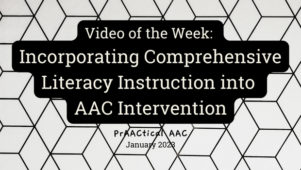
The work of Drs. Karen Erickson and David Koppenhaver on comprehensive literacy instruction in AAC has inspired many educators and therapists to ramp their literacy support in education and therapy. In today’s featured video, SLP Kristin M. Ellis shares her ideas of how to infuse this into clinical work with children and adults who have complex communication needs. Many thanks to AbleNet and to Kristin for making this archived presentation available. You can access the slide handout here and the supplemental resource list here. Direct Link to Video – https://www.youtube.com/watch?v=7zTUoFwbbhA&ab_channel=ableUOn-demandProfessionalDevelopment
December 5, 2022
by Carole Zangari -
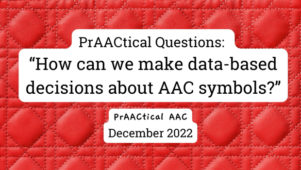
Data isn’t the only thing we use in AAC decision-making, but it’s a good-sized slice of the pie. Those using the feature match approach to AAC device/app selection, a gold standard for several decades, use direct assessment procedures to guide the selection of AAC devices and apps based on the features they contain. The symbol set(s) or systems(s) available in each AAC tool is one of the features that we consider. In this post, we share some of the assessment tasks that can be used to gain insight into how individuals do with different types of AAC symbols. In each one, the task is repeated with a specific type of symbol, so that we can make an apples-to-apples comparison. This part of the assessment is time-consuming and generally done over multiple sessions. These are drawn from the work of the later Dr. David Beukelman, and his co-authors, Dr. Pat Mirenda... [Read More...]
November 24, 2022
by Carole Zangari -
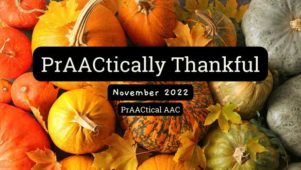
grat·i·tude /ˈɡradəˌt(y)o͞od/ noun the quality of being thankful; readiness to show appreciation for and to return kindness In the spirit of our American tradition of Thanksgiving, we pause to reflect on our blessings and offer thanks. We’re grateful for: The people who use AAC and their families for all they do to help us get better at this business of supporting communication Service providers in homes, schools, clinics, hospitals, and community agencies The university programs that have a dedicated AAC class, especially if they have a permanent faculty member with expertise in this area Bonus thanks to those that also offer supervised clinical or student teaching experiences with AAC mentorship opportunities or an AAC lab with SGDs, AAC apps, switches, and mounts. The professional and service organizations that support AAC through professional development opportunities, grants, mentorship programs The power of e-communication platforms for the AAC support on listservs, blogs, groups, threaded... [Read More...]
November 21, 2022
by Carole Zangari -
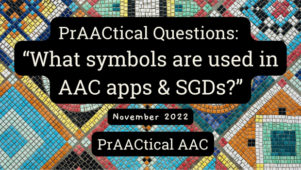
Welcome to the first of a 5-part series on symbols in AAC. Today, we’re starting off with a simple list of graphic symbols used in aided AAC tools. Graphic symbols are 2-dimensional images used to represent words and ideas visually. Print or traditional orthography is the one we’re using right now for this post, but most AAC apps and SGDs use some form of pictographic symbol in addition to that. Some of those symbols are free and others are available only through an additional purchase option or a subscription service. These are the ones used most commonly in communication books/boards and AAC apps/devices by individuals with complex communication needs around the world. You’ll recognize the most commonly used symbols, but some of these may be less familiar depending on where you live, work, play, and learn. If we missed your favorite symbol set or system, please let us know so... [Read More...]
October 10, 2022
by Carole Zangari -
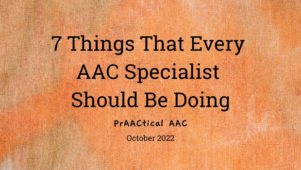
While our focus each October is on building awareness of AAC and promoting acceptance of those who use it, the month also gives us an opportunity to look inward. Today, we propose 7 activities that we believe to be the hallmark of those who specialize in AAC. If you consider yourself an AAC expert or someone who specializes in AAC, we invite you to reflect on these ideas. Those who specialize in AAC should belong to and engage with organizations in their state or region whose mission focuses on support for people with complex communication needs. Those who specialize in AAC should belong to and engage with national and/or international groups that elevate the role of AAC in society. Those who specialize in AAC should be active contributors to those organizations, whether it be through their time, expertise, or financial support. Those who specialize in AAC should critically evaluate new... [Read More...]
October 3, 2022
by Carole Zangari -
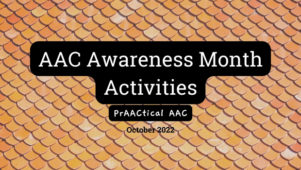
Established in 2007 by ISAAC’s LEAD Committee, AAC Awareness month invites us to spread the word about all things AAC, and it’s pretty exciting to think back on all we’ve done and also to plan for the current year. Each week during AAC Awareness Month we’ll share suggestions for things to do to help others learn about a field that emerged to support children and adults with complex communication needs. This week, we’ll focus on hands-on activities. A popular approach to AAC Awareness Month is to invite a group of colleagues or families to come together and communicate only through AAC for the event. Some years, we’ve held ‘Silent Snack’ events before class where we put out a variety of board games and invited some of our AAC clients to come in and play along. They enjoyed serving as our AAC Ambassadors, meeting new people, and ‘wow-ing’ the crowd with... [Read More...]
September 12, 2022
by Carole Zangari -
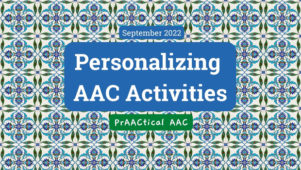
Like most learners, those with complex communication needs perk up when they see themselves, their family and friends, and their favorite things/places embedded into instruction or therapy. When we personalize materials and activities to each individual, we often see an increase in engagement and enjoyment. And those, in turn, lead to better outcomes. How can we put a personal spin on things we use in our AAC teaching? Here are a few ideas. Photos and videos of familiar people, places, and objects can be very impactful. Not all families are open to this and not all schools/agencies permit it. But when it IS an option, there’s nothing better to spark higher levels of engagement. We can substitute photos of family, friends, and favorite characters for generic photos/images in games, books, and learning materials to draw and retain their interest. We can talk about what they are doing and build language... [Read More...]
September 3, 2022
by Carole Zangari -
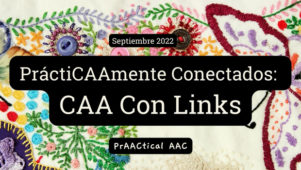
Each month we feature a Spanish version of our AAC Link Up, CAA con Links. If you have AAC-related announcements, materials, or videos in Spanish that you would like others to know about, we’d love to have you add that information below. Also, please share this with anyone who might be interested in contributing to or using the materials that get added to these posts. You’ll find the place to add that information at the very bottom of this post. Organized by Claudia Marimón, these monthly posts also feature AAC work being done in Spanish-speaking countries and offer translations of material that can help families and service providers. Today’s post focused on literacy and AAC and includes a recording of a presentation from the 2022 AAC in the Cloud Conference, hosted by CoughDrop. Don’t forget to scroll to the bottom to add your link and see what others are sharing.... [Read More...]
August 10, 2022
by Carole Zangari -
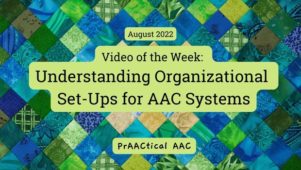
Despite the large number of AAC devices and apps available for people with complex communication needs, there are only a handful of different approaches to organizing words and messages. Understanding the difference, advantages, and disadvantages of each is a critical part of doing a good assessment and making appropriate AAC recommendations. Today, we feature a presentation on this topic by AAC/AT experts Beth Poss and Kelly Fonner. Originally offered as part of the AAC in the Cloud Conference, hosted by CoughDrop, this is a helpful video that you won’t want to miss. Many thanks to Beth and Kelly for sharing their expertise and experience, and to the fine team at CoughDrop for making this archived presentation available. You can obtain the handout for the session here. Direct Link to Video – https://www.youtube.com/watch?v=ef57eYip318&ab_channel=CoughDrop
August 8, 2022
by Carole Zangari -
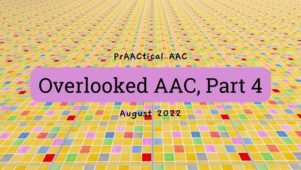
Most employees have job descriptions that offer clarity about what is expected of them and what they are supposed to achieve. Countless professionals work in fields where a Scope of Practice helps them know what they should and shouldn’t be aiming for. Many students have syllabi and rubrics that show them what they’ll need to do for a particular course or assignment. When people, organizations, and systems point us in the right direction, it’s easier for us to meet expectations and achieve goals. This holds true for individuals with AAC needs as well, but professionals often have so many competing priorities that we don’t always make a plan for how to do it. And when we do, we don’t always have the time and bandwidth to fully implement it. Today, we continue the Overlooked AAC series with a look at things that professionals often miss in supporting AAC users when... [Read More...]









